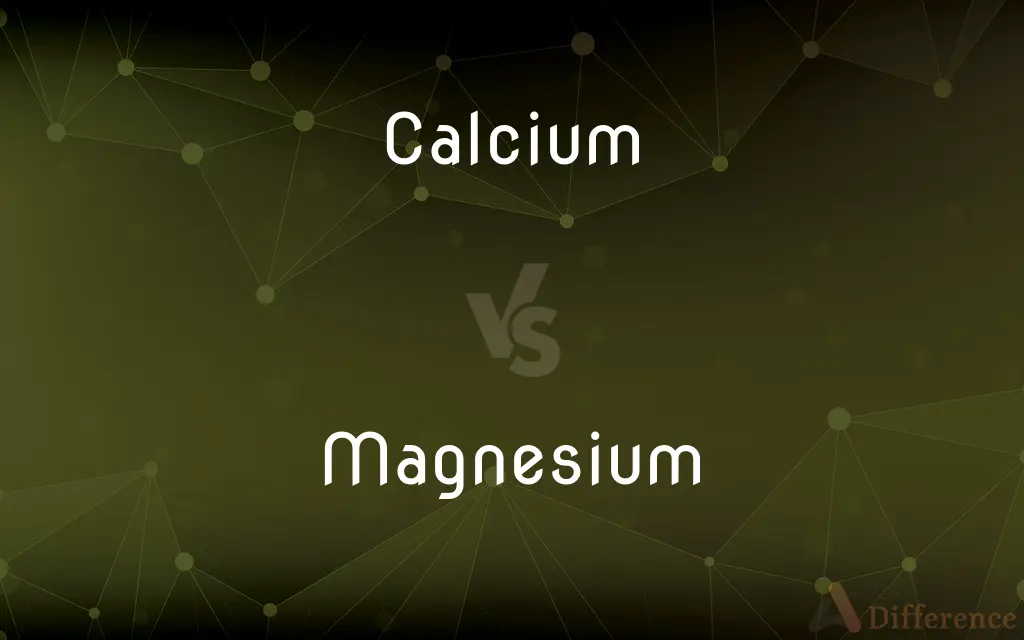Calcium vs. Magnesium — What's the Difference?
By Tayyaba Rehman & Maham Liaqat — Updated on April 5, 2024
Calcium is crucial for bone health and muscle function, while magnesium supports energy production and enzyme function.

Difference Between Calcium and Magnesium
Table of Contents
ADVERTISEMENT
Key Differences
Calcium is a mineral primarily known for its role in building and maintaining strong bones and teeth. It's also essential for blood clotting, muscle contraction, and nerve signal transmission. On the other hand, magnesium is involved in over 300 biochemical reactions in the body, including energy production, protein synthesis, and muscle and nerve function. While both are vital minerals, their specific roles and functions in the body's physiological processes differ significantly.
Calcium's presence in the diet is critical from childhood through adulthood, with dairy products being a major source. It helps prevent osteoporosis and is vital for maintaining bone health. Whereas magnesium is found in green leafy vegetables, nuts, seeds, and whole grains, playing a key role in managing diabetes, hypertension, and preventing migraines.
The body requires calcium in relatively large amounts, making it the most abundant mineral in the human body. Adults need about 1000-1200 mg of calcium per day depending on age and gender. In contrast, magnesium requirements are lower, with recommended daily amounts being around 320-420 mg for adults, highlighting the body's need for these minerals in different quantities.
Calcium's overconsumption can lead to health issues like kidney stones and impaired absorption of other minerals. Magnesium, while less commonly associated with such risks, can cause gastrointestinal distress and, in extreme cases, electrolyte imbalances when taken in excess.
Both minerals interact within the body, where adequate levels of magnesium help manage calcium levels, preventing potential negative effects of calcium overconsumption. This interplay emphasizes the importance of a balanced intake of both minerals for optimal health.
ADVERTISEMENT
Comparison Chart
Primary Function
Bone health, muscle function, nerve transmission
Energy production, enzyme function, muscle and nerve function
Daily Requirement
1000-1200 mg for adults
320-420 mg for adults
Sources
Dairy products, leafy greens, fortified foods
Nuts, seeds, whole grains, green leafy vegetables
Overconsumption Risks
Kidney stones, impaired mineral absorption
Gastrointestinal issues, electrolyte imbalances
Role in Body
Most abundant mineral, essential for bones and teeth
Involved in over 300 biochemical reactions
Deficiency Symptoms
Osteoporosis, dental problems, muscle spasms
Muscle cramps, behavioral disorders, hypertension
Compare with Definitions
Calcium
Vital for the blood clotting process.
Calcium's role in clotting is critical for wound healing.
Magnesium
Acts as a cofactor for numerous enzymes.
Magnesium's role is crucial in DNA repair and replication.
Calcium
Necessary for proper nerve signal transmission.
Calcium aids in transmitting signals between neurons.
Magnesium
Important for the creation of proteins.
Adequate magnesium is required for muscle building.
Calcium
Plays a crucial role in muscle contraction.
Adequate calcium intake supports smooth muscle operation.
Magnesium
Linked to reducing anxiety and depression.
Magnesium intake can improve mood and reduce stress levels.
Calcium
Important for healthy teeth.
Calcium consumption can prevent dental issues like cavities.
Magnesium
Involved in creating ATP, the body's energy currency.
Magnesium is essential for maintaining energy levels.
Calcium
Essential for developing and maintaining strong bones.
Milk is a rich source of calcium.
Magnesium
Supports muscle relaxation and nerve function.
Magnesium helps prevent muscle cramps.
Calcium
Calcium is a chemical element with the symbol Ca and atomic number 20. As an alkaline earth metal, calcium is a reactive metal that forms a dark oxide-nitride layer when exposed to air.
Magnesium
Magnesium is a chemical element with the symbol Mg and atomic number 12. It is a shiny gray solid which bears a close physical resemblance to the other five elements in the second column (group 2, or alkaline earth metals) of the periodic table: all group 2 elements have the same electron configuration in the outer electron shell and a similar crystal structure.
Calcium
A silvery, moderately hard alkaline-earth metal that constitutes approximately 3.6 percent of the earth's crust and is a basic component of most animals and plants. It occurs naturally in limestone, gypsum, and fluorite, and its compounds are used to make plaster, quicklime, Portland cement, and metallurgic and electronic materials. Atomic number 20; atomic weight 40.08; melting point 842°C; boiling point 1,484°C; specific gravity 1.54; valence 2. See Periodic Table.
Magnesium
A light, silvery-white, moderately hard metallic element that in ribbon or powder form burns with a brilliant white flame. Obtained chiefly from magnesite, dolomite, and bodies of salt water, it is used in structural alloys, pyrotechnics, flash photography, and incendiary bombs. Atomic number 12; atomic weight 24.305; melting point 650°C; boiling point 1,090°C; specific gravity 1.738 (at 20°C); valence 2. See Periodic Table.
Calcium
The chemical element (Symbol Ca), with an atomic number 20. It is a soft, silvery-white alkaline earth metal which occurs naturally as carbonate in limestone and as silicate in many rocks.
Magnesium
The chemical element (symbol Mg) with an atomic number of 12. It is a light, easily flammable, silvery-white alkaline earth metal.
Calcium
(countable) An atom of this element.
Magnesium
A light silver-white metallic element of atomic number 12, malleable and ductile, quite permanent in dry air but tarnishing in moist air. It burns, forming (the oxide) magnesia, with the production of a blinding light (the so-called magnesium light) which is used in signaling, in pyrotechny, or in photography where a strong actinic illuminant is required. Its compounds occur abundantly, as in dolomite, talc, meerschaum, etc. Symbol Mg. Atomic weight, 24.305. Specific gravity, 1.75.
Calcium
An elementary substance; a metal which combined with oxygen forms lime. It is of a pale yellow color, tenacious, and malleable. It is a member of the alkaline earth group of elements. Atomic weight 40. Symbol Ca.
Magnesium
A light silver-white ductile bivalent metallic element; in pure form it burns with brilliant white flame; occurs naturally only in combination (as in magnesite and dolomite and carnallite and spinel and olivine)
Calcium
A white metallic element that burns with a brilliant light; the fifth most abundant element in the earth's crust; an important component of most plants and animals
Common Curiosities
What are the main functions of calcium and magnesium in the body?
Calcium is vital for bone health and muscle function, whereas magnesium supports energy production and enzyme function.
Why is magnesium important for athletes?
It plays a key role in muscle function, energy production, and protein synthesis.
Can you get enough calcium and magnesium from diet alone?
Yes, with a balanced diet including dairy, leafy greens, nuts, and whole grains.
How do calcium and magnesium work together in the body?
Magnesium helps regulate calcium levels, promoting balance and preventing adverse effects.
Are there specific foods that are good sources of both calcium and magnesium?
Green leafy vegetables like spinach are rich in both minerals.
What are the symptoms of calcium and magnesium deficiency?
Calcium deficiency can lead to osteoporosis; magnesium deficiency might cause muscle cramps and hypertension.
Can taking supplements for calcium and magnesium be harmful?
Supplements can lead to overconsumption risks if not taken as advised by a healthcare provider.
How does the body absorb and use calcium and magnesium?
Calcium absorption requires vitamin D; magnesium is utilized in over 300 biochemical reactions.
How do daily requirements for calcium and magnesium differ?
Adults require more calcium (1000-1200 mg) than magnesium (320-420 mg) daily.
Can magnesium help with stress and anxiety?
Yes, magnesium has been linked to reduced anxiety and improved mood.
What happens if you consume too much calcium or magnesium?
Excess calcium can lead to kidney stones; too much magnesium might cause gastrointestinal issues.
What role does calcium play in cardiovascular health?
Adequate calcium intake is linked to reduced hypertension and cardiovascular disease risk.
What dietary adjustments can improve calcium and magnesium intake?
Including more dairy, leafy greens, nuts, and whole grains in your diet.
Is it possible to have a magnesium overdose from food?
Overdose from food is rare; it's more commonly associated with excessive supplement intake.
How does calcium affect muscle function?
It's crucial for muscle contraction and relaxation.
Share Your Discovery

Previous Comparison
Paleolithic vs. Mesolithic
Next Comparison
Milk vs. CreamAuthor Spotlight
Written by
Tayyaba RehmanTayyaba Rehman is a distinguished writer, currently serving as a primary contributor to askdifference.com. As a researcher in semantics and etymology, Tayyaba's passion for the complexity of languages and their distinctions has found a perfect home on the platform. Tayyaba delves into the intricacies of language, distinguishing between commonly confused words and phrases, thereby providing clarity for readers worldwide.
Co-written by
Maham Liaqat












































